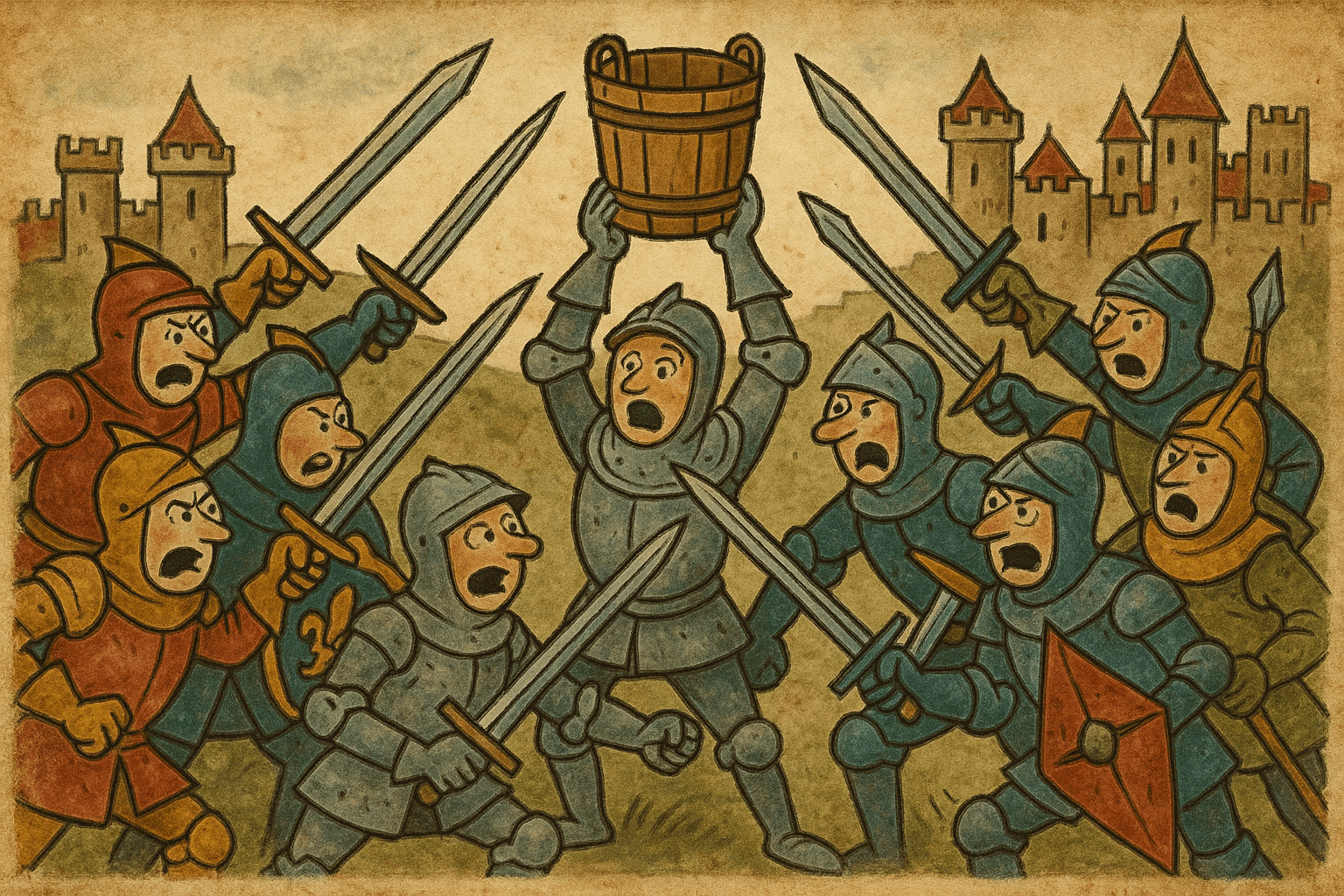This strange but true tale from medieval Italy is more than just a historical punchline. It’s a perfect window into a world of fierce civic pride, tangled politics, and the simmering rivalries that defined life in the Italian city-states.
A Boiling Pot of Rivalries: Medieval Italy
To understand why anyone would wage a war over a bucket, you first need to understand the political tinderbox that was 14th-century Northern Italy. Forget a unified nation; this was a chaotic patchwork of fiercely independent and wealthy city-states—Florence, Milan, Venice, Bologna, Modena—all jostling for power, land, and control over lucrative trade routes. Each city was a world unto itself, bursting with pride and a deep-seated suspicion of its neighbors.
Stirred into this local mix was a much larger, continent-spanning conflict: the struggle between the Guelphs and the Ghibellines.
- The Guelphs supported the authority of the Pope.
- The Ghibellines backed the Holy Roman Emperor.
For centuries, these two factions tore Italy apart. While the feud began as a high-minded political debate, it quickly descended into a convenient banner for local squabbles. Being a Guelph or a Ghibelline was like picking a side in the ultimate political derby; it gave cities an excuse to formalize their hatred for the Ghibelline city just down the road. This is precisely where our two protagonists enter the scene: Bologna was a staunchly Guelph city, while their nearby rival, Modena, was proudly Ghibelline. The two had been trading insults and raiding each other’s farmlands for generations.
The Bucket, the Border, and the Boiling Point
By 1325, tensions between Bologna and Modena were already at a fever pitch after years of border skirmishes. The atmosphere was ripe for an incident—and that incident came in the form of some audacious Modenese soldiers.
As the story goes, a small group of Modenese troops snuck into the heart of Bologna under the cover of darkness. They didn’t sack a treasury or burn a palace. Instead, they made their way to the city’s central well and stole the oaken bucket used to draw water. They then scurried back to Modena to display their prize in triumph.
To the modern mind, this sounds like a fraternity prank. But to Bologna, it was a profound humiliation. The central well was a hub of public life, a symbol of the city itself. The bucket, while ordinary, was their public property. Its theft was a brazen, mocking gesture that struck at the very heart of Bolognese honor. Infuriated, Bologna’s magistrates demanded the immediate return of their bucket. Modena, reveling in their rivals’ fury, flatly refused.
And so, over a water pail, Bologna declared war.
The Battle of Zappolino: A Bloody Day for a Pail
Bologna was not messing around. As the aggrieved party and a larger city, they mustered an enormous Guelph army. Sources claim they fielded around 30,000 foot soldiers and 2,000 knights, a formidable force led by Pope John XXII’s own nephew. Confident in their numbers, they marched toward Modena, ready to teach their rivals a lesson and reclaim their stolen property.
Modena, though outmanned, was better prepared. Assembling a Ghibelline force of just 5,000 foot soldiers and 2,000 knights, they were a lean, experienced fighting machine. On November 15, 1325, the two armies clashed at Zappolino, in what would be one of the bloodiest battles of the medieval period.
The battle lasted only a couple of hours, but the carnage was immense. Against all odds, the smaller but better-led Modenese army decisively routed the massive Bolognese force. The disciplined Ghibellines broke the Guelph lines, sending the Bolognese army into a panicked retreat. The Modenese pursued them all the way back to the gates of Bologna, slaughtering thousands along the way. While they lacked the strength to lay siege to the city itself, they added one final insult: they paraded outside Bologna’s walls, taunting their defeated foes before finally heading home.
Estimates put the death toll at around 2,000 men. All for a bucket.
More Than Just a Bucket: Civic Pride and Symbolism
So, was it really all about a wooden pail? Of course not. The bucket was merely the catalyst—the physical object upon which decades of hatred, rivalry, and political tension could be focused. This conflict is a prime example of campanilismo, a uniquely Italian concept.
Campanilismo is the intense loyalty and pride a person feels for their hometown, symbolized by its bell tower (campanile). It suggests that one’s identity is tied not to a nation, but to the specific city block, neighborhood, and public square where they live. The oaken bucket wasn’t just wood and rope; it was a piece of Bologna’s public soul. To steal it was to steal a piece of their identity.
For Modena, keeping the bucket transformed it from a simple pail into a legendary trophy. It became a permanent, tangible symbol of their improbable victory at Zappolino and a constant reminder of Bologna’s humiliation. It represented Ghibelline triumph over Guelph might, the ultimate “bragging right” in a world where honor was everything.
The Legacy of a Wooden Trophy
In the end, peace was brokered, as it always was. But Bologna never got its bucket back. To this very day, the legendary oaken bucket (or at least, a centuries-old replica of it) is proudly displayed in Modena’s town hall, enshrined in the Torre della Ghirlandina. It remains a quiet, wooden testament to a time when civic pride was a matter of life and death.
The War of the Oaken Bucket serves as a comical yet powerful reminder that the motivations for human conflict are not always grand or even logical. It shows us how potent symbols can be, and how a simple object can become the focus of immense pride, hatred, and, ultimately, war. It is a perfect, peculiar slice of history, proving that reality is often far stranger—and far more entertaining—than fiction.
